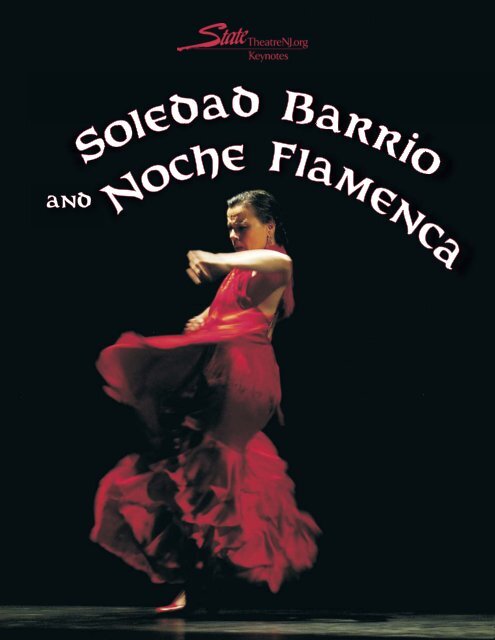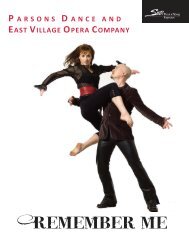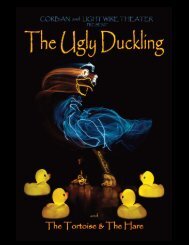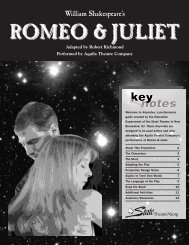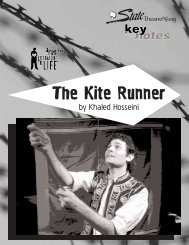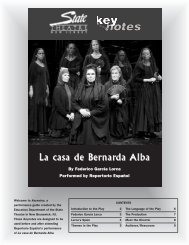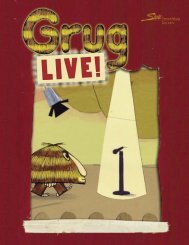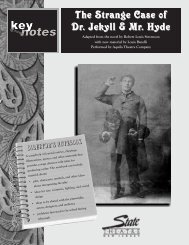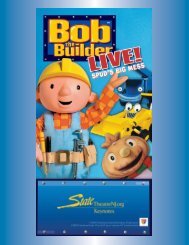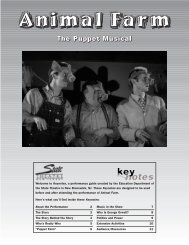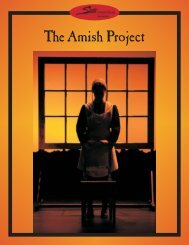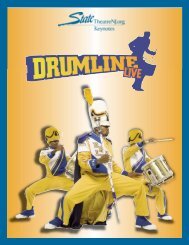Soledad Barrio and Noche Flamenca - State Theatre
Soledad Barrio and Noche Flamenca - State Theatre
Soledad Barrio and Noche Flamenca - State Theatre
You also want an ePaper? Increase the reach of your titles
YUMPU automatically turns print PDFs into web optimized ePapers that Google loves.
<strong>and</strong><strong>Soledad</strong><strong>Noche</strong><strong>Barrio</strong><strong>Flamenca</strong>
Welcome 2The <strong>State</strong> <strong>Theatre</strong> in New Brunswick, New Jersey welcomesyou to the school-day performance by world-renownedflamenco dancer <strong>Soledad</strong> <strong>Barrio</strong> <strong>and</strong> <strong>Noche</strong> <strong>Flamenca</strong>. Thiscolorful, high-energy show introduces the centuries-old artform of flamenco. It is an art form that acknowledges its richhistory, but also looks forward to the future, absorbing newideas <strong>and</strong> rhythms that reflect flamenco’s multicultural origins.These Keynotes will help you underst<strong>and</strong> <strong>and</strong> enjoy theperformance. We hope that this guide will also help you findconnections between what you see on the stage <strong>and</strong> your ownpersonal experience.ContentsWelcome ....................................................................................................2<strong>Soledad</strong> <strong>Barrio</strong> <strong>and</strong> <strong>Noche</strong> <strong>Flamenca</strong> ............................................3The Program ............................................................................................4What is Flamenco? ................................................................................5The Elements of Flamenco..................................................................6Flamenco Dance......................................................................................7Flamenco Guitar ......................................................................................8Flamenco Rhythms ................................................................................9Talking Flamenco..................................................................................10Flamenco: Roots & Routes ..............................................................11The Roma ................................................................................................12Classroom Connections ....................................................................13Things to Know Before You Go ......................................................14Keynotes are made possible by agenerous grant from Bank of AmericaCharitable Foundation.The <strong>State</strong> <strong>Theatre</strong>’s education program is funded in part by Bank of America Charitable Foundation, City of NewBrunswick, the Geraldine R. Dodge Foundation, E & G Foundation, Gannett Foundation, The William G. <strong>and</strong> HelenC. Hoffman Foundation, Horizon Foundation for New Jersey, Johnson & Johnson Family of Companies, J. SewardJohnson, Sr. 1963 Charitable Trust, Karma Foundation, Blanche <strong>and</strong> Irving Laurie Foundation, Magyar BankFoundation, McCrane Foundation, MetLife Foundation, National Starch, Inc., New Jersey <strong>State</strong> Council on theArts, PNC Foundation, the Provident Bank Foundation, PSE&G, Robert Wood Johnson Foundation, TD Bank, <strong>and</strong>Wachovia Foundation. Their support is gratefully acknowledged.Funding to the <strong>State</strong> <strong>Theatre</strong> is provided by Mid Atlantic ArtsFoundation in partnership with the National Endowment for the Artsthrough the American Recovery <strong>and</strong> Reinvestment Act of 2009.Online at www.<strong>State</strong><strong>Theatre</strong>NJ.org/KeynotesKeynotes are produced by the EducationDepartment of the <strong>State</strong> <strong>Theatre</strong>, NewBrunswick, NJ.Wesley Brustad, PresidentLian Farrer, Vice President for EducationKeynotes for Flamenco! written <strong>and</strong> designedby Lian Farrer.Contributing editor: Jillian FioreEdited by Katie Pyott <strong>and</strong> Jennifer Cunha.© 2009 the <strong>State</strong> <strong>Theatre</strong>Funding has been made possiblein part by the New Jersey <strong>State</strong>Council on the Arts/Departmentof <strong>State</strong>, a partner agency of theNational Endowment for the Arts.ContinentalAirlines is theofficial airlineof the <strong>State</strong><strong>Theatre</strong>.The Heldrichis the officialhotel of the<strong>State</strong> <strong>Theatre</strong>.Find us at www.<strong>State</strong><strong>Theatre</strong>NJ.orgContact: education@<strong>State</strong><strong>Theatre</strong>NJ.orgThe <strong>State</strong> <strong>Theatre</strong>, a premier nonprofit venue forthe performing arts <strong>and</strong> entertainment.Cover photo courtesy of Steve Mayeda.
<strong>Soledad</strong> <strong>Barrio</strong> <strong>and</strong> <strong>Noche</strong> <strong>Flamenca</strong> 3About the CompanyPraised by critics worldwide, <strong>Noche</strong> <strong>Flamenca</strong> is recognized as the mostauthentic flamenco touring company in the field today. The company wasfounded in Madrid in 1993 by Artistic Director Martín Santangelo <strong>and</strong> hiswife, <strong>Soledad</strong> <strong>Barrio</strong>. Over the years, they have emerged as one of Spain’smost successful flamenco ensembles. Performance highlights includeregular seasons in New York City <strong>and</strong> Buenos Aires, performances inAustralia, Greece, <strong>and</strong> Egypt, <strong>and</strong> annual tours in North America. Thecompany has been recognized with awards from the National DanceProject (2006), the National Endowment for the Arts (2007 & 2008), <strong>and</strong> theLucille Lortel Award for Special Theatrical Experience (2003).<strong>Noche</strong> <strong>Flamenca</strong>’s artistic vision is to present <strong>and</strong> preserve the heart <strong>and</strong>soul of flamenco: the communal spirit that springs from theinterconnectedness of dance, song, <strong>and</strong> music. In support of its mission, thecompany offers extensive education <strong>and</strong> residency programs for people ofall ages. The members of <strong>Noche</strong> <strong>Flamenca</strong> are based in Spain, withcompany offices in New York City.“Our goal is to maintainthe essence, purity, <strong>and</strong>integrity of one of theWorld’s most complex<strong>and</strong> mysterious artforms Without the use oftricks or gimmicks.”—<strong>Soledad</strong> <strong>Barrio</strong> <strong>and</strong><strong>Noche</strong> <strong>Flamenca</strong><strong>Soledad</strong> <strong>Barrio</strong>A native of Madrid, <strong>Soledad</strong> <strong>Barrio</strong> didn’t begin formal dance traininguntil she was 18. “I started studying very late, but the only thing Iremember about my childhood is that I wanted to dance,” she says. Shebegan her training at Amor de Dios, the Center for Flamenco Art <strong>and</strong>Spanish Dance in Madrid. “It was an obsession,” she recalls. “Every hour Iwould dance until my muscles were shot.”<strong>Soledad</strong> <strong>Barrio</strong> has appeared as a soloist with Manuela Vargas, Blancadel Rey, Luisillo, El Guito, Manolete, Cristobal Reyes, <strong>and</strong> El Toleo, BalletEspanol de Paco Romero, Festival Flamenco, <strong>and</strong> many other companies.She has performed throughout Europe, Japan, <strong>and</strong> North <strong>and</strong> SouthAmerica with such artists as Alej<strong>and</strong>ro Granados, Isabel Bayón, Jesus Torres,Miguel Perez, Belen Maya, Manolo Marin, Javier Barón, Merce Esmeralda,Rafael Campallo, <strong>and</strong> Belen Maya. She has won awards from over 12different countries around the globe for her excellence in dance. Sherecently received a “Bessie” award for Outst<strong>and</strong>ing Creative Achievement.She is a founding member of <strong>Noche</strong> <strong>Flamenca</strong> with her husb<strong>and</strong> MartínSantangelo.<strong>Soledad</strong> <strong>Barrio</strong> <strong>and</strong> Juan OgallyPhoto courtesy of Marie Daix
The Program 4Nuestro SonA joyous presentation of different aspects of flamenco:the song, the guitar, women’s role in flamenco, men’srole in flamenco, etc. The choreography begins byseparating the differents aspects to give a perspectiveof each variation of flamenco. The dance graduallybuilds <strong>and</strong> blends the elements together, culminatingin a celebration with the whole company.Solo de MusicaThis short piece shows off the technique <strong>and</strong> artistry ofthe guitarist.TientosTientos are among the most majestic, rhythmic, <strong>and</strong>sensual of the flamenco dances. They speak of brokenlove, but then of hope through the blossoming ofwomanhood.FarrucaThe farruca is a solo dance, similar to tangos,traditionally performed only by men. It is thought tohave originated in Galicia in northwestern Spain.AlegríasThe word alegría is Spanish for “joy.” In this famousdance from the city of Cádiz, a couple celebrates younglove, <strong>and</strong> all the trials <strong>and</strong> tribulations that envelop it.CanteA duet performed by the two singers that expressesthe oldest <strong>and</strong> purest form of flamenco <strong>and</strong> their ownpersonal interpretations of song. The texts reflect thejoys <strong>and</strong> sorrows of everyday life <strong>and</strong> love.SoleáSoleá (pl. soleares) is one of the most popular forms offlamenco. It is a solo dance rooted in solitude <strong>and</strong>loneliness.Fin de FiestaA celebration of dance, song, <strong>and</strong> music.“In that moment [When] there isfluidity With the singer <strong>and</strong> themusic, something happens that hasneVer been rehearsed. That is realcommunication.”—<strong>Soledad</strong> <strong>Barrio</strong>?<strong>Soledad</strong> <strong>Barrio</strong> <strong>and</strong> Eugenio Iglesias. Photo courtesy of Marie DaixHave you ever seen or heard about flamenco?What do you expect the performance to look<strong>and</strong> sound like?Does the U.S. have a type of dance that reflectsour history, culture, or national character? If we do,how would you describe it? What makes itAmerican? If we don’t, why not?
What Is Flamenco? 5Flamenco is a traditional style of dance, guitar playing, <strong>and</strong> song from theAndalusia (Andalucía) region of southern Spain. Flamenco is highly dramatic.The performers’ ultimate goal is to express a strong emotional idea—such aspassion, joy, sadness, loneliness, or humor.The history of flamenco goes back hundreds of years. No one can say forcertain when or how flamenco began, but it clearly grew out of a mixture ofdifferent cultures: Andalusian, Islamic, Jewish, <strong>and</strong> Gypsy, to name the majorinfluences. Flamenco has many styles <strong>and</strong>forms. These are grouped into about 50different categories, known as palos. Eachpalo comes with its own set of rulesgoverning rhythm, harmony, tempo, versestructure, etc. Within these rules, theperformers are free to improvise—makeup the music, dance steps, <strong>and</strong> words—as they are performing them. For thisreason, no two flamenco performancesare ever completely the same.Flamenco is still practiced today, <strong>and</strong> is enjoying growing popularity. Inthe 1980s a movement known as nuevo flamenco (new flamenco) promoted afusion of flamenco <strong>and</strong> other styles of music <strong>and</strong> dance. Artists are mixingflamenco with tango, jazz, rock, salsa, Afro-pop, <strong>and</strong> even hip-hop!Flamenco is song.Flamenco is music.Flamenco is dance.Flamenco is feeling.Flamenco is life... loVe...pain... rage... passion...<strong>Soledad</strong> <strong>Barrio</strong>Photo courtesy of <strong>Noche</strong> <strong>Flamenca</strong>The Birthplace of FlamencoFlamenco originated in ANDALUCÍA, a region insouthern Spain that includes the provinces of Almería,Cádiz, Córdoba, Granada, Huelva, Jaén, Málaga, <strong>and</strong>Seville. Its capital is the city of Seville. The region’sclimate varies: subtropical on the Mediterranean coast,tem perate on the Atlantic coast, <strong>and</strong> cooler temperaturesin the highl<strong>and</strong>s, where snow is not un usual. The warmclimate of the valleys <strong>and</strong> plains is ideal for growingoranges, olives, sugarcane, wheat, corn, <strong>and</strong> other grains.The history of Andalusia is an eventful one; since thedistant past, it has been settled or conquered by manydifferent civilizations—people from Africa <strong>and</strong> the MiddleEast to northern Europe. Each of these groups left alasting impression on the culture of the region, includingthe music, dance, <strong>and</strong> song of flamenco.Andalucía
The Elements of Flamenco 6There are three main elements that work together to create aflamenco performance: dance, guitar, <strong>and</strong> song. These elementsare combined in different ways to create the many categories offlamenco performance, each with its own balance of music,rhythm, <strong>and</strong> movement.DANCE (BAILE)In flamenco, the dancing is very dramatic. For men, the dancemovements involve complicated toe- <strong>and</strong> heel-clicking steps(taconeo), while the traditional women’s dance is based moreon graceful arm <strong>and</strong> h<strong>and</strong> movements.GUITAR PLAYING (TOQUE)A flamenco guitar is slightly smaller <strong>and</strong> lighter than a classicalguitar. The flamenco guitarist (tacaor) uses special playingtechniques, rhythms, <strong>and</strong> harmonies in their music.<strong>Soledad</strong> <strong>Barrio</strong> <strong>and</strong> <strong>Noche</strong> <strong>Flamenca</strong>Photo courtesy of Zarmik MoqtaderiSONG (CANTE)Flamenco began as purely vocal music, with no accompaniment other than h<strong>and</strong>claps. The role of the singer (cantaor/cantaora) is still very important. Both words <strong>and</strong> melody of the songs are improvised around traditional rhythms <strong>and</strong>chords. The singer strives for duende—an emotional connection with the audience through the power of the music.PALOSThere are more than 50 different palos—categories—of flamenco. Each palo has its own mood, rhythmic pattern, <strong>and</strong>performing traditions. Some are sung with no instrumental accompaniment, while others may use a guitar <strong>and</strong> otherinstruments. Some palos are danced while others are not. Some are traditionally performed only by men or only bywomen, while others might be performed by men <strong>and</strong> women.ShoW us Your “Duende”!Flamenco dancers use their bodies to express duende (DWENday),a word that can be translated as “soul,” “emotion,” “spirit,” or“magnetism.” What are some of the physical ways we use our bodiesto show who we are or how we are feeling?1. Choose an emotion <strong>and</strong> create a shape with your body thatshows that emotion. Practice your shape until it looks the sameevery time you do it, <strong>and</strong> make sure you can hold it withoutmoving or speaking.2. Demonstrate your shape for the rest of your class. Let them walkaround you while you remain frozen in position. You shouldremain silent, but your audience should say aloud what they see.Does your shape look strong? Happy? Frightened? Melancholy?Can they guess the emotion expressed by your shape?
Flamenco Dance 5Flamenco dance is immediately recognizable for the rhythmic stomping ofthe feet <strong>and</strong> the sweeping movements of the arms. The dancers spend yearslearning the specialized movements <strong>and</strong> rhythms that are used in a flamencoperformance. Using these rules <strong>and</strong> traditions as a guide, the dancersimprovise (make up their moves on the spot) rather than perform routinesthat are choreographed (planned out in advance).Flamenco dancing is different for men <strong>and</strong> women. The male dancer(bailaor) focuses on complex foot movements <strong>and</strong> does not use the upperbody very much. In contrast, a female dancer (bailaora) mostly uses gracefulmovements of the hips, h<strong>and</strong>s, <strong>and</strong> arms, <strong>and</strong> also her skirt (falda) <strong>and</strong> shawl(mantan). The movement of her h<strong>and</strong>s is called the floreo, <strong>and</strong> the movementof her arms is known as the braceo.The dancer’s footwork (zapateado or taconeo) requires specialshoes (zapatos) with nails driven into the soles. Just like the metalplates used on the bottom of tap-dance shoes, the nails helpbring out the sound of the footwork. Flamenco dancers usedifferent parts of their feet to produce different sounds <strong>and</strong> rhythms. Thepicture on the right shows the flamenco terms for the different foot parts thatare used to strike the floor.Flamenco CostumeTACÓN(heel)GOLPE(entire flat foot)<strong>Soledad</strong> <strong>Barrio</strong> <strong>and</strong> Alej<strong>and</strong>ro GranadosPhoto courtesy of Esther BabbPLANTA(ball of the foot)PUNTA(toe)Costume is a major element of flamenco style. The dancers use their costumes(as well as their faces <strong>and</strong> bodies) to express themselves.Male flamenco dancers traditionally wore close-fitting black pants with a shirt<strong>and</strong> close-fitting short jacket or vest. In more recenttimes, the short jacket has been replaced by a loosefittingsuit jacket or no jacket at all.The women wear long dresses,sometimes (but not always) with theThis flamencobata de cola—a long skirt withcostume featuresmany layers of ruffles. The bata dethe long skirtcola weighs about ten pounds <strong>and</strong> trails five feetknown as thebehind the dancer! Throughout the dance, the women lift <strong>and</strong> shakebata de cola.the ruffles to emphasize their movements. In old-style flamenco,female dancers also wear a long, fringed shawl (mantan) folded into av-shaped pattern <strong>and</strong> often tied around the waist. The shawls addcolor <strong>and</strong> pattern to the flamenco clothing <strong>and</strong> help accentuate themovement of the hips. Elaborately decorated fans, often trimmed withlace, are sometimes used by female dancers to show off elegant h<strong>and</strong> <strong>and</strong>arm movements.
Flamenco Guitar 8TUNINGPEGNUTFRETSFINGERBOARDSOUND HOLEBODY}NECKThe guitar is played all over the world, in many styles of music besidesflamenco: classical, rock, folk, jazz, <strong>and</strong> more. The first guitars, dating back to15th-century Spain, were very small, <strong>and</strong> were strung with four pairs of strings.In the late 1700s, the double strings were replaced by six single strings.Like the string instruments in an orchestra, the guitar is made from thinpieces of wood that are glued together, coated with varnish, <strong>and</strong> baked. Guitarstrings were originally made from cat-gut; today they are usually metal ornylon. They are attached at the top by PEGS. From the pegs, the strings travelover a small piece of wood called the NUT, down the NECK <strong>and</strong> over theBODY <strong>and</strong> SOUND HOLE to the BRIDGE. The guitar is tuned by turning thepegs to tighten or loosen each string. Tightening makes the string shorter,producing a higher pitch, while a looser/longer string creates a lower pitch.The guitar is played by plucking the strings with the fingers of the righth<strong>and</strong>. With the fingers of the left h<strong>and</strong>, the guitarist presses the strings downagainst the FINGERBOARD, shortening individual strings to create thedifferent notes. A guitarist can play just one string at a time, or two, three, orall six strings at once. Plucking the strings makes them vibrate, which is whatmakes the sound. The hollow body <strong>and</strong> sound hole of the guitar help makethe sound louder.The guitar used in flamenco is smaller <strong>and</strong> lighter than the instrumentused by classical musicians. Several types of wood go into a flamenco guitar:cypress for the back <strong>and</strong> sides, cedar for the fingerboard, pine or spruce forthe top, rosewood for the bridge, <strong>and</strong> ebony for the fretboard.The flamenco guitar was originally used to accompany singers <strong>and</strong>dancers. Recently, solo flamenco guitar has developed into a separate artform. Flamenco guitar techniques include rasgueado—strumming thestrings with outward flicks of the fingers; golpe—tapping the bodyof the guitar with the fingers to emphasize the rhythm; <strong>and</strong>tremolo—where high notes are played very quickly to make a“trembling” sound.BRIDGEThe flamenco guitar is an acoustic instrument, whichmeans it does not use any electronics to produceits sound. Most popular music—such as rock<strong>and</strong> jazz—mostly uses electric guitars, whichlook <strong>and</strong> sound very different from theiracoustic cousins. The electronic componentsof electric guitars gives them greater volumethan an acoustic guitar, as well as a widerrange of sounds <strong>and</strong> effects. Since theyuse an electronic amplifier, electricguitars do not need a deep, hollow body<strong>and</strong> sound hole to project the sound.
Flamenco Rhythms 9COMPÁS (RHYTHM)The foundation of flamenco is rhythm. Flamenco artists use theterm compás for the different rhythms that keep the singers,musicians, <strong>and</strong> dancers together during a performance. To lose therhythm (fuera compás) is considered a serious fault in a flamencoperformer. Flamenco rhythms are very complex; often you will hearseveral different rhythms being played at the same time.Rhythm instruments used in flamenco include the h<strong>and</strong>s, feet,palillos (pa-LEE-yos), <strong>and</strong> the cajón (kah-HONE), a box-shaped drumplayed with the h<strong>and</strong>s. Sometimes even the guitarist joins in byslapping the body of the instrument like a drum to emphasize thebeat.PALMAS (HANDCLAPS)Palmas, or h<strong>and</strong>claps, are usedto help keep the rhythm, <strong>and</strong> also toencourage the other performers. Thereare two types of palmas:• sordas - “deaf” palmas, a muffledpalmas sordash<strong>and</strong>clap made by clapping togetherthe cupped palms of the h<strong>and</strong>s• secas - “dry” palmas, loud h<strong>and</strong>claps madeby hitting the cupped palm of the lefth<strong>and</strong> with the three middle fingers ofthe right h<strong>and</strong>. Another term for thispalmas secaskind of h<strong>and</strong>clap is palmas claras, or“clear” palmas.PALILLOSKnown in English as castanets, in Spanish as castañuelas, <strong>and</strong> inflamenco as palillos, thispercussion instrument helpsaccent the rhythm of the music.Palillos are made from twospoon-shaped pieces of woodtied together with a string. Toplay palillos, fasten the string aroundyour thumb <strong>and</strong> rest the instrumentagainst the palm of the h<strong>and</strong>. Use yourfour fingers to strike the two piecestogether, making a clicking sound.palillosBeat It!cajónMost of the music we listen to has arhythm based on 3 or 4 beats. Flamenco,however, often uses a 12-beat rhythm. See ifyou can master a couple of them.Begin by clapping steadily like a fastheartbeat, counting out loud from 1-12 witheach clap.Now try this 12-beat pattern, used inflamenco dances such as the soleá,alegría, <strong>and</strong> bulería. Clap 12 times, butthis time make beats 3, 6, 8, 10, <strong>and</strong> 12 muchlouder than the other 7 claps. Your clappingpattern should be:1 23 4 5 6 7 8 9 10 11 12It may make it easier to count aloud the12 claps in groups as follows, clapping loudlyonly on the 1’s:12 1 2 3 1 2 1 2 1 2 1Now try your h<strong>and</strong> at learning the rhythmof the seguiriya <strong>and</strong> the martinete.This time the loud beats are beats 1, 3, 5, 8,<strong>and</strong> 11. Your clapping pattern should be:1 2 3 4 5 6 7 8 9 10 11 12You can also count aloud the 12 claps forthis rhythm in groups as follows:1 2 1 2 1 2 3 1 2 3 1 2Keep repeating these patterns over <strong>and</strong>over, until you’ve got them!
Talking Flamenco 10Andalucía - a region in southernSpain <strong>and</strong> birthplace of flamencobailaor/bailaora - a male/femaleflamenco dancerbaile - dancebata de cola - the long, ruffled skirt<strong>and</strong> train on a flamenco dressbraceo - the arm movements of theflamenco dancercajón - a drum shaped like a box<strong>and</strong> played with the h<strong>and</strong>scantaor/cantaora - a male/femaleflamenco singercante - songcastañuelas - “castanets,” a h<strong>and</strong>percussion instrument that makesa clicking soundchico - “little”; in flamenco itdescribes a fast, happy songcompás - the special rhythms usedin flamencoduende - the emotional force thatinspires flamencoescobilla - a long solo that showsoff the flamenco dancer’sfootworkfalda - flamenco dancer’s skirtflamenco - a style of music, song,<strong>and</strong> dance from Andalucía, Spainfloreo - the movement of theflamenco dancer’s h<strong>and</strong>sgolpe - stamping the floor with theentire bottom of the footguitarra - guitarjaleo - shout of encouragement <strong>and</strong>approvaljondo - “deep”; in flamenco itdescribes a slow, sad songllamada - a signal or call that theflamenco dancer gives to theguitarist to change the rhythmmantan - shawlpalillos - another word forcastañuelaspalmas - rhythmic h<strong>and</strong> clappingused as an accompaniment toflamencopalos - the different styles offlamencopitos - finger snapping used as anaccompaniment in flamencoplanta - stamping the floor with theball of the footpunta - stamping the floor with thetip of the toeRoma - also known as Gypsies, oneof the cultures that createdflamencoseca - “dry”; in flamenco used todescribe loud, high-pitchedh<strong>and</strong>claps (palmas)soleá - one of the basic palos offlamenco, a slow, solemn stylealso known as solearessorda - “mute”; in flamenco used todescribe quiet h<strong>and</strong>claps(palmas)tacón - stamping the floor with theheeltaconeo - the heel movements usedin flamenco dance; also used todescribe footwork in generaltocaor/tacaor - a male/femaleflamenco guitaristtoque - guitar playingzapateado - footworkzapatos - shoesJaleo<strong>Soledad</strong> <strong>Barrio</strong>Photo by TelamDuring the performance, you willfrequently hear the performers calling outto each other. Their expressions ofapproval <strong>and</strong> encouragement are knownas jaleo (ha-LAY-oh). You might hearthem calling out some of these words<strong>and</strong> phrases:¡Olé!Asi se cantaAsi se tocaAsi se bailaAndaVamos yaEso esDo you know the meaning of theseSpanish words? Do we have anythingsimilar to jaleo in this country? Where?
Flamenco: Roots & Routes 1137521468Flamenco Timeline1100 Phoenicians found Cádiz.500 Greeks colonize Spain, introducing a forerunner ofcastanets.200 Romans annex Spain, introducing a forerunner ofthe guitar.100 Jews migrate to Spain.BCAD771 Moors (Muslims from North Africa) conquersouthern Spain. For the next 8 centuries, Muslims,Christians, <strong>and</strong> Jews coexist under Islamic rule.1400s Gypsies from northern India reach Spain.1469 Ferdin<strong>and</strong> & Isabella marry; Spain unified underCatholicism; Spanish Inquisition persecutes non-Catholics for next 330 years1492 First anti-Gypsy laws in Spain1500s African slaves are brought into the region.1560 More stringent anti-Gypsy laws are passed inSpain.1600s Latin American influences on flamenco begin.1745 Gitanos (Gypsies) in Spain must settle down or beexecuted.1869-1910 “Golden Age” of flamencoToday12345678Flamenco influences <strong>and</strong> is influenced by culturaltraditions from around the world.Flamenco has been evolving for more than 600 years. Atruly multicultural art form, it has been influenced by the variedpeoples who have lived in Andalucía over the centuries—particularly the Roma (or Gitanos, Spanish Gypsies). The roots offlamenco extend far <strong>and</strong> deep: to Cuba, Egypt, Greece, India,Morocco, <strong>and</strong> other regions in Eastern Europe <strong>and</strong> the MiddleEast. It blends Moorish (from northern Africa), Jewish, <strong>and</strong>Christian traditions. Later contributions came from LatinAmerica, <strong>and</strong> especially Cuba.Flamenco is not written down, but passed on from onegeneration to the next. In this way, it continues to absorb newrhythms <strong>and</strong> new ideas.Flamenco FusionCreate a physical timeline of flamenco in your classroomby stringing a line of yarn around the walls. Divide your classinto small groups to research what was happening atdifferent periods in history. Use index cards to label or drawevents that helped shape flamenco <strong>and</strong> attach them to theappropriate place on the timeline.Think of an example of cultural fusion besides flamenco—in music, dance, film, food, or even in your neighborhood orfamily. Describe this fusion. What are the cultures or elementsthat are combined?
The Roma 12One of the most important groups in the development of flamencoare the Roma, commonly called Gypsies in English <strong>and</strong> Gitanos inSpanish. (Roma is the preferred name.) Originally from India <strong>and</strong> Pakistan,the Roma migrated to different parts of the world as early as 400 A.D.Today there are an estimated 12 million Roma worldwide, with abouttwo-thirds living in Europe.Some cultural elements that are common to Roma worldwide includea common language (Romani), a strong sense of group identity, <strong>and</strong> arejection of traditions from the outside world. Many Roma are traditionalnomads, moving from place to place in their caravans. Romani tribes aredivided into clans, groups of related families. Marriages usually take placeat a young age—12 or 13—<strong>and</strong> are generally arranged by the couple’sparents.Since the 14th century, the Roma have been widely persecutedwherever they have traveled, including the U.S. During World War II(1939-1945) 500,000 Roma perished in Nazi concentration camps.Though discrimination continues today, the Roma have becomeincreasingly active in working to establish their rights <strong>and</strong> preserve theirheritage. In 1979 the United Nations recognized the Roma as a distinctethnic group.The Roma first arrived in Spain around 1425, at the start of a period of greatsocial, political, <strong>and</strong> religious conflict. Spain’s Christian kingdoms werereaching the end of a nearly 700-year campaign to reclaim the regionfrom Islamic rule. When the last Muslim stronghold fell to King Ferdin<strong>and</strong>V <strong>and</strong> Queen Isabella I in 1492, Spain completed the transformation froma collection of independent kingdoms into a single large, Roman Catholicmonarchy. This period marked the beginning of the Spanish Inquisition(1478-1834), when non-Catholics were severely persecuted: forced toconvert to Catholicism, expelled from the country, or even put to death.Though they were not treated as severely as the Jews or Muslims, the Romasuffered under laws <strong>and</strong> practices designed to undermine their culture. Largegroups of Roma ended up migrating south to Andalucía, a more remote region ofSpain where they were slightly more tolerated. Behind closed doors, flamencoflourished. Absorbing the musical influences of Muslims <strong>and</strong> Jews, the Romacreated songs <strong>and</strong> dances that reflected their life under the Inquisition. It is fromthis period that flamenco takes its traditional themes of sadness <strong>and</strong> struggle,resistance <strong>and</strong> survival—themes that are still alive in flamenco songs today.The end of the Inquisition meant greater tolerance for the Roma <strong>and</strong> theirculture. In southern Spain, flamenco dance schools began to appear in the 1760s.The Golden Age of flamenco (1869-1910) saw the creation of cafés cantantes,cafés where audiences paid to see flamenco performances. This kind of publicexposure helped to popularize flamenco throughout Spain.A Spanish Romani girl from Granada. Note thesimilarity of her clothing, hair, <strong>and</strong> posture toelements of traditional flamenco style.Art as aMirrorFlamenco began as anart form shaped byimmigrant <strong>and</strong>marginalized peoples. It often reflectsthe feelings <strong>and</strong> experiences of theoppressed.Find a poem, song, or paintingthat reflects the artist’s ideas aboutsome kind of social or politicalinjustice. How does it make you feel?Would you have the same emotionsif you simply read an account of theunjust situation in a book or article?Why do you think art is used sofrequently to express big ideas aboutthe world we live in?
Classroom Connections 13DiscoVer the L<strong>and</strong> of FlamencoWorking with one or two classmates, investigate one aspect of theregion of Andalucía or of the city of Córdoba. Here are somesuggested topics:• government • music • history• geography • education • art• cuisine • language • current issuesReport back to the rest of the class about what you learned.Build a Word WallAfter the performance, brainstorm with your class as many words asyou can think of to describe the show: what it looked <strong>and</strong> soundedlike, how it made you feel, things it made you think of, etc. Write allthe words on the blackboard. This is your word wall.Working on your own, select ten words from the wall that you thinkdescribe yourself. Write a poem or essay (at least one paragraph)about yourself that uses the words you chose from the word wall.For extra credit, find out the Spanish word for each word from thewall you used for your personal essay.Write a ReVieWAfter the show, write a review of theperformance. Don’t just say if you liked it ornot; be sure to say why. Use specific examplesfrom the performance to support youropinions. Here are some elements of theperformance you can discuss in your review:• the music• the singing• the dancing• the costumes• the lighting• the teamwork among the performers• the variety of the pieces performed• the balance of the different elements:were the toque, cante, <strong>and</strong> baile allgiven equal importance?Share your review with the <strong>State</strong> <strong>Theatre</strong>.Email it to:education@statetheatrenj.org.
Things to KnoW Before You Go 14A performance is only a performance ifthere’s an audience to see <strong>and</strong> hear it. As amember of the audience, you are a partnerwith the artists in bringing the performanceto life.LiVe performances haVespecial rules.Attending a live performance is not thesame as watching a movie or television show.You will be in the same space with theperformers <strong>and</strong> the rest of the audience. Anynoises or movements you make will disturbthe artists <strong>and</strong> spoil the experience for therest of the audience. Here are some basicrules to follow at the theater:• Before the performancestarts, turn off <strong>and</strong> putaway all electronicdevices—cellphones,iPods, games, etc. Andplease, no texting or webbrowsing during the show!• Do not bring food orbeverages into the theater.• Stay in your seat.• No talking or whispering once the showbegins.• Do not take photos or make any video orSHOWSTARTING—TTYL!sound recording of the show.KnoW your role.During the show, your job is to focus allyour energy <strong>and</strong> attention on what’shappening onstage. The way you respond tothe show matters a great deal to theperformers. Laugh at the funny parts.Applaud if you like what you see <strong>and</strong> hear.When the performance ends, stay in yourseat until your group is dismissed by the<strong>State</strong> <strong>Theatre</strong> staff.ResourcesBOOKS:Flamenco!, by Gwynne Edwards; photographs by Ken Haas. Thames &Hudson, 2000.Gypsies <strong>and</strong> Flamenco, by Bernard Leblon. University of HertfordshirePress, 2003.Indigenous Peoples of the World - The Gypsies, by Anne Wallace Sharp.Lucent Books. 2002.Song of the Outcasts: An Introduction to Flamenco, by Robin Totton.Amadeus Press, 2003 (book & CD).MUSIC:Best of Flamenco, Arc Music, 1998.Legends of Gypsy Flamenco. Arc Music, 2002.Masters of Flamenco Guitar. Blue Note Records, 1997The Rough Guide to Flamenco. World Music Network, 2007.VIDEO:Carlos Saura’s Flamenco Trilogy (Blood Wedding, Carmen, El amorbrujo). Eclipse from Criterion, 2007. Rated PG.Flamenco, directed by Carlos Saura. New Yorker Video, 1997. Not rated.<strong>Soledad</strong> <strong>Barrio</strong> <strong>and</strong> <strong>Noche</strong> <strong>Flamenca</strong> on YouTube:www.youtube.com/watch?v=kh8H9PDE3tQINTERNET:<strong>Soledad</strong> <strong>Barrio</strong> <strong>and</strong> <strong>Noche</strong> <strong>Flamenca</strong> website:www.nocheflamenca.comAndalusia <strong>and</strong> its culturewww.<strong>and</strong>alusia-web.com/culture.htmPhoto courtesy of Marie Daix


